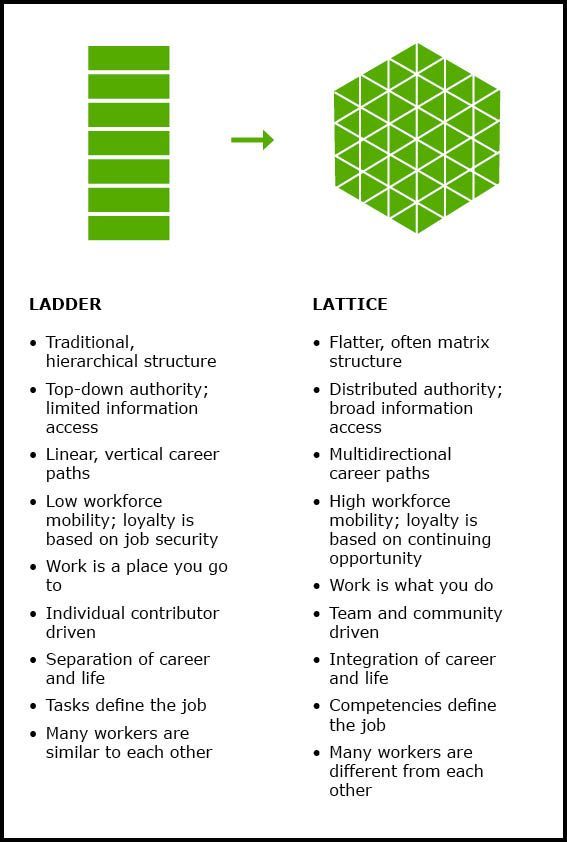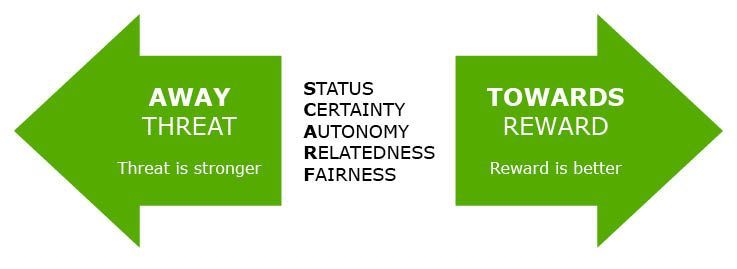In today’s complex, interconnected and rapidly changing environment, it is more important than ever that organisations can respond quickly whilst still achieving efficiencies of scale. A key enabler of this is having the right organisational design, and recognising that the design of yesterday (designed for efficiency and assuming predictable patterns) will no longer work in the digital age, where agility and speed of response is key.

Matrix working – please click to enlarge the image
All your practices need to combine in the service of cohesively driving the business strategy in this environment, and good organisational design does this by taking into account:
- Customers
- Processes
- Systems
- Culture
- People practices
Nowadays, whilst hierarchy is still present, organisations also model matrix working, cross-functional working and flexible teams. Flexible teams, in particular, are key to enabling the agility required to compete – coming quickly together and then disbanding quickly.
In addition, I am seeing communities being formed to drive specific agendas and influence their organisation’s culture (e.g. employee wellbeing; building a reputation for innovation; creating a feeling of community at one site where there are disparate functions). This is typically done at site level, but could also be done at functional level.
What this means to you as a leader
Good leadership is about holding these different tensions, positively, to move the organisation forward. For more on this, please see my article Introducing leadership agility, in particular, the section about the catalyst leadership style.
Leaders need to continue to look to the future, and keep the organisation ready to face the opportunities and challenges that may come along, while being responsive to the customer demands of today. For more on this, please see my article on Futurism: Future-proofing yourself and your business.
Organisations used to shift between a centralised and a de-centralised model; this simplicity is now outdated. With matrix working comes a need to develop a different set of skills, and utilise managers to co-ordinate and collaborate; more on this will follow in a future article.
When I am involved in any organisation design, the starting point is to have a clearly articulated vision and strategy, and then to identify any gaps in your organisational capability (and cross-reference to the capabilities your competitors have, as a benchmark). These might include systems, processes, expert knowledge, culture and values. Addressing gaps will leverage your competitive advantage going forward.
Questions to ask yourself
- What is your vision?
- What is your strategy to achieve the vision?
- How does your organisation compare with your competitors?
- What gaps do you need to close?
- What strengths do you have that you need to retain and capitalise on?
- Do you truly push decision-making down to its lowest level, in particular, to functions that can affect the customer experience?
- How effective are your communication and knowledge-sharing channels?
- How can you enable cross-collaboration between teams as well as collaboration within them?
- How clear are roles and responsibilities, so teams know exactly what they are accountable for? Organisations will always have some form of hierarchy, and there will always be power bases – so you need clear and explicit governance structures that set this out.
- What culture do you need to drive your vision? What will enable this? What type of people do you need to attract, retain and develop?
- Do you have a system that contains accurate data on the skills, experience and successes of all your people – to enable forming of new teams quickly, as well as effective talent management
- Do you have clear metrics in place so you can measure, track progress, demonstrate (and celebrate) success? What are you rewarding in terms of output and behaviour, and what needs to shift to make you an agile orgnisation?
- Have you made it easy for people to do their job? In employee opinion survey results, this is often highlighted as an area for improvement. So remove roadblocks such as bureaucratic processes and decision-making, and systems that are slow or not user-friendly. Line managers are often best placed to pay attention to this, because they are close enough to the work, and have the influence to collaborate with peers to address these roadblocks
- Do you continually promote flexible working, and reward by deliverables achieved rather than for hours spent behind a desk?
- Does your culture allow people to speak up and challenge the status quo? Bring people together to test assumptions, protocols and company rituals, and to bring in new ideas
- Are the power bases in your organisation helping or hindering? Do they look forward or back? Do egos impede collaboration and diversity of thought? Do leaders focus on their own area or on the overall organisation?
Communication issues
When an organisational design is required, be aware that it can throw up uncertainty and emergent power games. Think of the book The Prince by Machiavelli.
Some people may take advantage of the fact that things are unclear around the direction of the business and their individual responsibility. Some might have held a position of influence and power which suddenly becomes unclear; others might take advantage of that to promote their own agenda.
It’s therefore wise to complete your organisational design as quickly as possible. When you’ve designed it, communicate:
- How the design links to the vision and strategy
- The governance / decision-making
- Metrics and measures of success
- How it all sits together, and why
- Any behaviour change you will now lead towards
- The process and timelines for implementing
You may have a transition plan, that is, a few iterations that will enable the design to evolve over time. If so, explain this so your people realise that it’s thought through consciously and is not just ad hoc.
More questions to consider
It’s imperative that your design is based on your future plans. So, is your vision and strategy clear? And is everyone committed to it (hearts and minds)?
What are your decision criteria and design principles?
Who will you involve in the organisation design process, and how will you involve them? How will you facilitate discussion, capture and review input and ideas?
What organisational design expertise do you need? Do you have this internally? If not, how will you buy it in? (Of course, The Padfield Partnership can help, hint, hint!)
Is this an opportunity for you to role model a new way of working, such as moving from a top-down approach to a more collaborative working style or moving from a performance to a learning organisation, where experimentation is embraced?
Do you need to call out any ‘sacred cows’, i.e. those topics that ought to be challenged, but people might assume that they can’t?
How can you ensure that you focus on the really important areas or opportunity, and gaps, and make sure that you don’t get bogged down with details and politics?
Tips for success
Ensure the leaders who are driving the process:
1. Model strong skills according to the Leadership agility compass. Specifically, they should have emotional intelligence, and an understanding of how people may feel threatened by this type of work, and the compassion to help them work through their feelings of threat.
Please click the image to learn more about the SCARF model
2. Understand the strategy, and be able to understand the different parts of the organisation and join the dots so it all hangs together. Also, understand what’s happening in the industry to bring the outside in. Have the capacity to understand and work through complexity.
3. Model and believe in the value of a win:win mindset.
Agile Principles – what can we learn from a group of 17 software developers?!
Agile was established in 2001 by a group of software developers to alter the way software was developed. They agreed four key values, shown below – which I think neatly summarise the approach likely to be successful, not just in software development but any new, emergent way of working:
People Over Processes and Tools
Projects should be built around motivated individuals who are given the support they need and trusted to get the job done. Teams should favour a fun, creative environment for problem-solving, and should maintain a sustainable pace. Employees should talk face-to-face and suggest ways to improve their work environment. Management should remove impediments to easier, more fruitful collaboration.
Working Prototypes Over Excessive Documentation
Innovators who can see their results in real market conditions will learn faster, be happier, stay longer, and do more valuable work. Teams should experiment on small parts of the product with a few customers for short periods, and if customers like them, keep them. If customers don’t like them, teams should figure out fixes or move on to the next thing. Team members should resolve arguments with experiments rather than endless debates or appeals to authority.
Respond to Change Rather Than Follow a Plan
Most detailed predictions and plans of conventional project management are a waste of time and money. Although teams should create a vision and plan, they should plan only those tasks that won’t have changed by the time they get to them. And people should be happy to learn things that alter their direction, even late in the development process. That will put them closer to the customer and make for better results.
Customer Collaboration Over Rigid Contracts
Time to market and cost are paramount, and specifications should evolve throughout the project, because customers can seldom predict what they will actually want. Rapid prototyping, frequent market tests, and constant collaboration keep work focused on what they will ultimately value.
Further reading on Designing Agile Organisations
The Corporate Research Forum recently published their research about Designing Adaptable Organisations for Tomorrow’s Challenges. To find out more, please read the executive summary.
The complete article is behind a paywall, but they have kindly allowed me to share their seven main recommendations (feel free to email me if you would like more information and I will pass your request on):
- Start with the business strategy
- Develop a process or model for organisation design
- Focus on ‘rewarded’ complexity (i.e. where it needs to be complex, does it add value, such as creating connection points to execute the strategy versus non-added value complexity such as unnecessary layers and duplication of effort?)
- Make sure design changes do not add unnecessary complexity
- Develop matrix-ready leaders (i.e. invest in developing leaders who can operate effectively in a matrix)
- Take the customer’s perspective
- Consider whether you need to invest in building organisation design capability in your organisation
The Business Transformation Network has posted this article in partnership with The Padfield Partnership.



